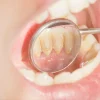Get information about Dental Filling treatment with the explanation of expert dentist Merve Özkan Akagündüz.
Dental Filling

Dental Filling, Doredent İstanbul
Dental filling is a dental treatment method used to clean and repair the decayed parts of the tooth or to repair the broken parts of the tooth and restore the function of the tooth. The dentist removes the damaged parts of the tooth and fills the resulting gap with filling material. Thanks to this procedure, further tooth decay is prevented, its function is restored and the aesthetic appearance is improved.
For the filling process, first the area to be filled is anesthetized with local anesthesia. This prevents the patient from feeling pain and discomfort during the procedure. Decayed or damaged tooth tissue is cleaned and the filling material is placed and shaped in the cleaned tooth cavity. A special light is used to harden the filler. The hardened tooth tissue is turned into a smooth and shiny surface with polishing rubbers. Dental filling is a one-session procedure. If the adjacent teeth need any filling, several filling procedures can be performed in the same session. After the filling procedure, the dentist checks the patient at regular intervals. In this way, new caries can be prevented and oral hygiene is kept at an optimum level.
If tooth decay is left untreated, the decay may progress and require root canal treatment. Root canal treatment is the last stage before tooth extraction, as it is a process in which the vitality of the tooth is eliminated. Therefore, cavities that can be saved with fillings need to be treated before they progress.
Tooth filling is not done only because of decay. It can also be used to repair teeth that are broken or worn due to trauma. There is no age limit for dental fillings. It can be applied to both permanent (permanent) teeth and milk teeth.
Types of Dental Fillings
There are many types of dental fillings. The priority here is your dentist’s evaluation. The dentist may explain to you the materials he deems appropriate and, in some cases, leave it to your choice. You should also consider various factors when making your choice. Your doctor’s recommendations, your aesthetic expectations and your economic conditions may be effective in this choice.
Amalgam Filling: It is a type of filling used in the back teeth since ancient times, and its content consists of a mixture of mercury, silver, copper and tin. Although it is durable and economical, it is no longer preferred today due to its dark color and the presence of mercury.
Composite Filling: Composite filling is made of resin-based materials. It is a durable product. Since they can be produced in tooth color, they can be used for aesthetic purposes. After it is adapted to the tooth, it is hardened with the help of a special device with UV light. Although it is more costly than amalgam, it is in great demand as it is a durable and aesthetic material. They both provide an aesthetic appearance on the front teeth and are durable enough to withstand the chewing forces on the back teeth. These are the main reasons why it is the most preferred dental filling.
Glass Ionomer Filler: It is a filling material consisting of a mixture of fluoroaluminosilicate and acrylic. It is a less durable material than composite filling. However, its fluoride secretion feature helps protect dental health. They are mostly used in the treatment of tooth root caries, as temporary filling material in adults, and in the treatment of children’s milk teeth. They can also be used safely by pregnant women.
Porcelain Filling (inlay and onlay): It is the filling material that is most compatible with the tooth. Making porcelain fillings is different from making other fillings. After the decay is cleaned in the first session, measurements are taken from the area and a temporary filling is applied to the patient. In the second session, the filling prepared in the laboratory is adapted to the tooth and polished. These fillings, prepared in a laboratory environment, can be made of gold, composite or ceramic material. They are extremely durable. Their compatibility with gums is quite good. They are superior to other fillings, especially in the repair of teeth with a lot of material loss. The fact that they require two sessions and are costly limits their use.
Oral care is very important for the longevity of dental fillings. Tooth brushing and flossing should be regular. Dentist check-ups should not be interrupted.
Tooth Filling Selection
The extent and localization of the material loss in the tooth play a role in choosing a dental filling. While resistance to chewing forces is important in the posterior teeth, aesthetics is more important in the front teeth.
Composite filling material is the most preferred filling type. They are used in both direct restorations and indirect restorations. Porcelain fillings are mostly used in indirect restorations. When the material loss in the tooth is low, the use of composite fillings is a better option, and when the material loss is high, porcelain inlays and onlays offer a better option.
Dental Filling Prices
Dental filling prices are affected by many factors depending on the area to be treated and the material to be used. You can get the most accurate information on this subject after the clinical examination. To give an idea, we can say that according to the price tariff prepared by the Turkish Dental Association for 2024, the prices of composite fillings recommended for one tooth vary between 1,640.00 TL and 2,560.00 TL.
Does a dental filling have a lifespan?
There are different types and qualities of dental filling materials. Producing the filling from good materials is an important factor in its longer life. In addition, it is necessary to use quality products to get an aesthetically satisfactory result. The quality of the filling material can be understood from its ability to adhere to the tooth, its consistency, wear rate over time, color change, color tones, heat conductivity and tendency to secondary caries formation.
The lifespan of dental fillings, how and in what quality the filling is made, is directly related to the oral hygiene status of the patient. In general, a period of 5-10 years can be given, but it is possible to extend this period with dentist checks.
Why Does a Filled Teeth Decay?
Tooth filling is done to eliminate material loss caused by caries or any other reason. It has no protective effect on other parts of the tooth. If oral care is not taken into consideration, the tooth may decay in the same or a different area. Sometimes, decay may occur under the filling due to cracks and fractures in the filling. To prevent such negative situations from occurring, 6-month checks are recommended.
Can a filling be performed without anesthetizing the tooth?
Local anesthesia is a procedure that prevents the patient from feeling pain and increases patient comfort, which we use in many dental procedures. However, some patients who have a fear of needles may shy away from this situation and not want anesthesia. In such a situation, first the depth of the decay is evaluated. If the decay has not gone below the enamel tissue, the procedure is possible without anesthesia. However, most of the time, when caries is diagnosed, the caries has already passed through the enamel tissue. The process of cleaning the decay that descends to the dentin under the enamel tissue can cause unbearable pain. Therefore, it is necessary to numb the tooth with local anesthesia.
Can Pregnant Women Have Dental Fillings?
One of the most curious questions about pregnancy is whether or not dental procedures have been performed. Dental fillings and other procedures can be performed at any time during pregnancy. However, the period between the 3rd and 6th months of pregnancy, which we call the 2nd trimester, is safer. It is more appropriate to perform non-urgent dental procedures during this period. Our biggest concern in pregnant women is to avoid taking x-rays as much as possible so that our patient is not exposed to radiation and the substances contained in local anesthetics. For this reason, it may be necessary to get an opinion from the patient’s gynecologist and obstetrician before dental procedures.
Keeping the oral hygiene of every patient planning pregnancy at an optimum level and having all dental procedures performed allows the pregnancy process to be more comfortable and peaceful. For this reason, it should not be forgotten that dental health is also a part of general health and necessary care should be taken.
Merve Özkan Akagündüz
I was born in Edirne in 1988. In 2007, I began my master’s degree in Dentistry at Istanbul University (Çapa) Faculty of Dentistry and graduated in 2012.
In 2014, I started my specialization in the Department of Orthodontics at Süleyman Demirel University Faculty of Dentistry. In 2019, I earned the title of Orthodontist and was appointed to Çorlu ADSM, where I worked as an Orthodontic Specialist Dentist from 2019 to 2022.
As of 2024, I have been continuing my practice in my own clinic.








